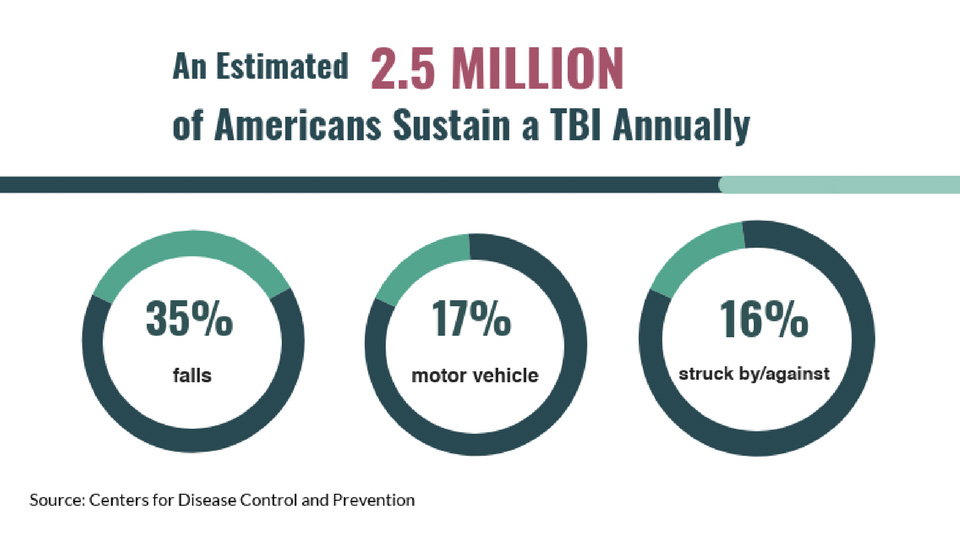Traumatic Brain Injury Awareness
Posted in

Brain injuries have been in the spotlight in recent years, and for good reason. Concussion diagnosis is on the rise in the U.S., increasing 43 percent from 2010 to 2015. March is Brain Injury Awareness Month, so we want to bring attention to the seriousness of brain injuries and educate you on post-injury symptoms that could be signs of trouble.
Brain injury types
- Hematoma - A collection, or clotting, of blood outside the blood vessels.
- Hemorrhage - Uncontrolled bleeding of the head.
- Concussion – A temporary unconsciousness caused by a blow to the head.
- Edema – The medical term for swelling.
- Skull fracture- A break in the cranial bone, also known as the skull.
About 75 percent of traumatic brain injuries that occur each year are concussions or other mild injuries. A TBI is caused by a bump, blow or jolt to the head that disrupts the normal function of the brain. The severity ranges from a mild change in consciousness to an extended period of unconsciousness or memory loss. Even though concussions aren’t life-threatening, they can have series side effects.
Causes of brain injuries
An estimated 2.5 million people sustain a TBI annually in the United States. According to the Centers for Disease Control, falls accounted for 35 percent of all TBI-related emergency visits and hospitalizations. Motor vehicle accidents were the second leading cause of TBI, accounting for about 17 percent. And being struck by/against an object is the third leading cause at 16.5 percent. People who are most likely to sustain a TBI are children (zero - four years of age), older adolescents (15-19 years of age) and adults 65 years and older.
Traumatic brain injury symptoms
Knowing what symptoms to look for can aid you in getting help faster and preventing further harm. Most symptoms may not be present or noticed at the time of injury and may be delayed days or weeks before they appear. Some of these symptoms are highlighted below.
- Loss of consciousness for several minutes to hours
- Appearing dazed or stunned
- A headache or pressure in the head
- Confusion
- Loss of coordination
- Dizziness
- Nausea or vomiting
- Slurred speech
- Fatigue
- Dilation of pupils
Effects of brain injuries
After a mild TBI, symptoms can last for weeks and may cause additional effects like vertigo, headaches, continued memory loss and changes in mood. If someone experiences a severe TBI, there may be a loss of consciousness for more than 30 minutes and memory loss after the injury. Other consequences of the injury range from damaged blood vessels, fluid buildup, seizures, nerve damage and even cognitive problems like memory impairments, learning difficulties, impaired judgment and concentration issues.
Second impact syndrome
Second Impact Syndrome occurs after a person suffers a second concussion before symptoms from an earlier concussion have cleared. With SIS, the brain may swell rapidly and could lead to a brain herniation. If a second concussion occurs, the person has a higher risk of respiratory failure, loss of eye movement and even death.
Athletes, veterans and people with a history of repetitive head trauma have also been linked to a degenerative brain disease called chronic traumatic encephalopathy.
Concussion recovery
Although most people fully recover in seven to 10 days after a concussion, it depends on the severity of the injury. Other factors impacting recovery include how bad the concussion was, their age, how healthy they were before the concussion and how they take care of themselves after the injury. Also, young children and older adults may take longer to recover from a mild concussion.
Therapy may also be required to heal from a traumatic brain injury. INTEGRIS Jim Thorpe Rehabilitation can help your brain learn alternative ways of working and minimize the long-term impact of the injury.
Traumatic brain injuries, like concussions, are very serious and should be closely monitored. If you notice a loved one experiencing any of the symptoms listed in this article after an injury, please contact emergency services or a primary health care provider.

